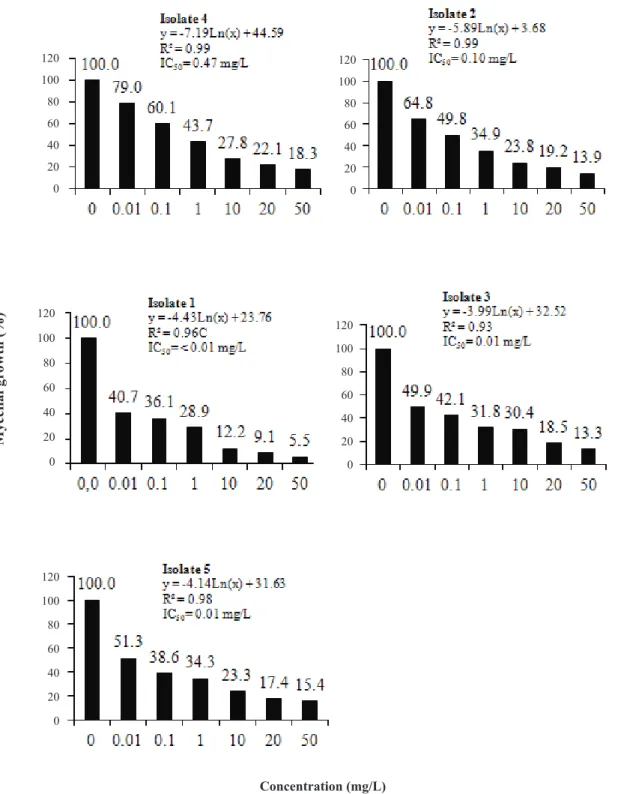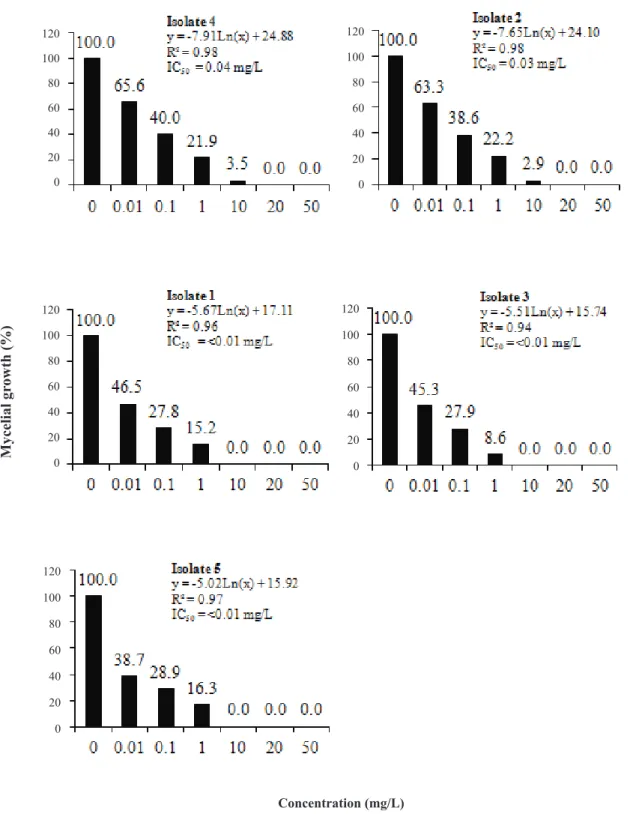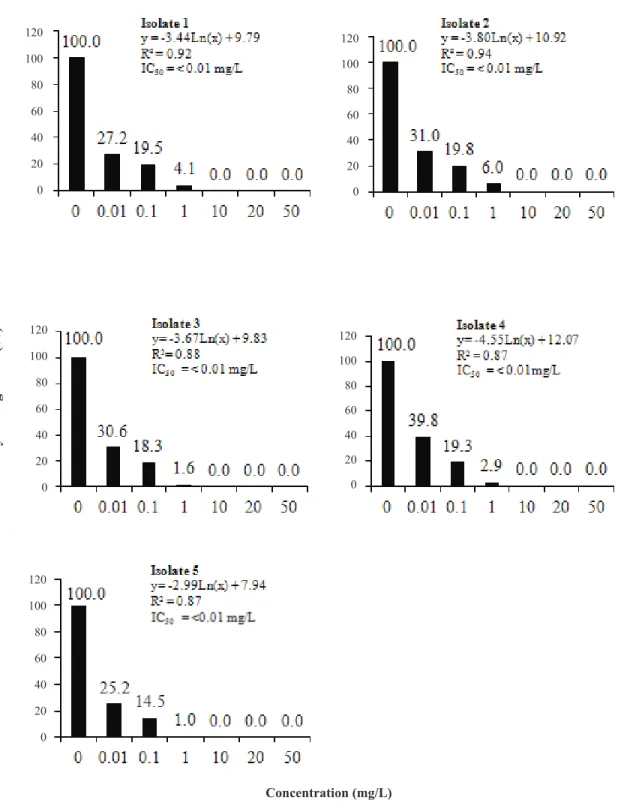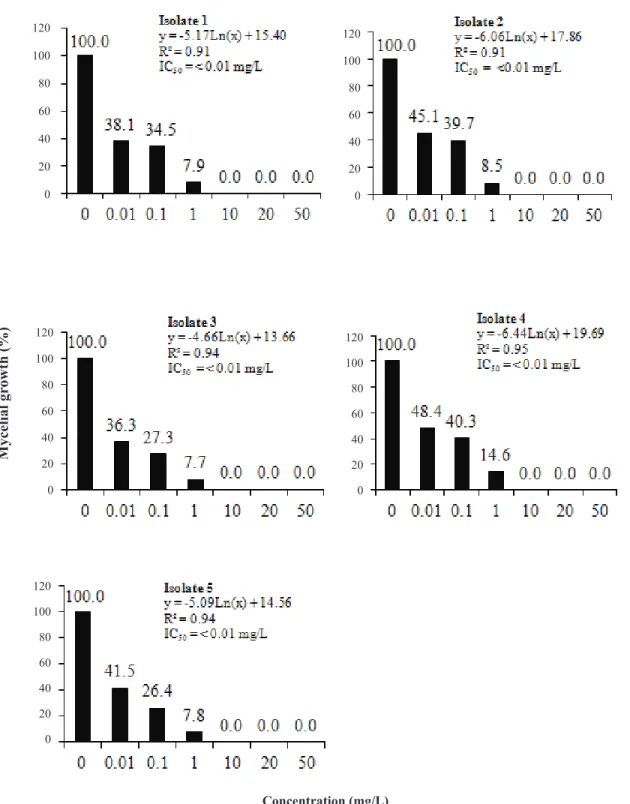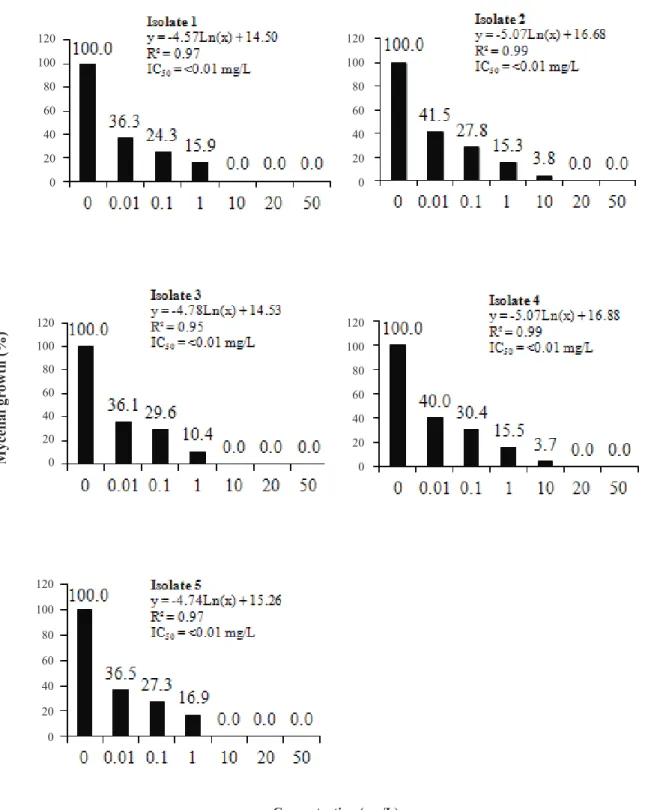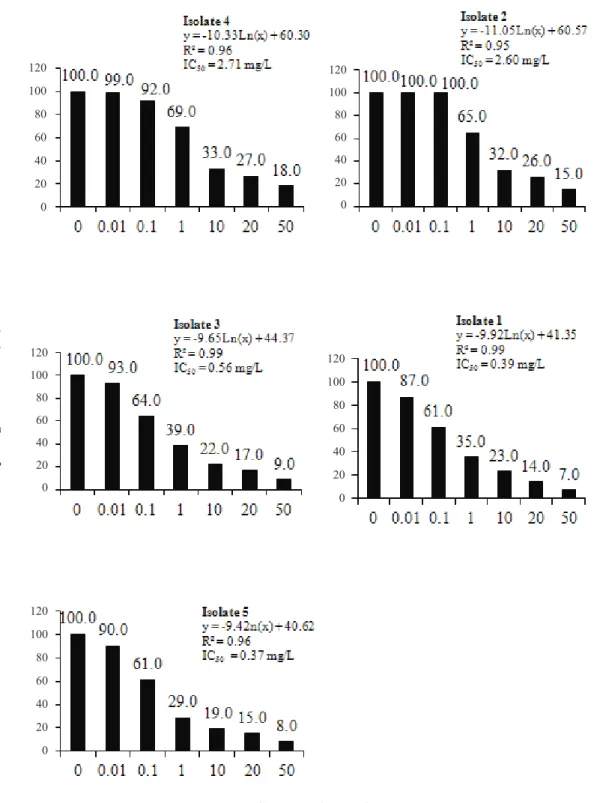Wheat (Triticum aestivum L.) is an important crop for food in Brazil. Its annual consumption is currently around 11 million tons, of which 6 million tons are produced and 5.6 million tons are imported. The amount of money spent on imports account for US$ 933.9 millions (5). Wheat production in Southern Brazil is a difficult task. The difficulties are directly related to excessive rain at the beginning of flowering up to crop ripening (15). Fungal diseases cause high damage
RESUMO
Palavras-chave adicionais: Fungitoxicidade, giberela, CI50, sensibilidade, Triticum aestivum. A giberela do trigo é uma doença de importância global. No Brasil, a doença
pode causar danos de até 27%. Como cultivares resistentes ainda não estão disponíves, o controle da doença num curto espaço de tempo, fundamenta-se no uso de fungicidas. O primeiro passo para alcançar manejo eficiente é a identificação de fungicidas potentes. Em experimentos in vitro, determinou-se a concentração inibitória de 50% (CI50) para o crescimento miceliano ou para germinação de conídios em função do grupo químico dos fungicidas de cinco isolados de Fusarium graminearum de diferentes origens. Os fungicidas inibidores da desmetilação (IDM) testados foram: epoxiconazol, cyproconazol, metconazol, procloraz, protioconazol e tebuconazol. Em adição, foram testados azoxistrobina, cresoxim-metílico, piraclostrobina e trifloxistrobina,
Avozani, A.; Tonin, R.B.; Reis, E.M.; Camera, J.; Ranzi, C. Sensibilidade in vitro de isolados de Fusarium graminearum a fungicidas. Summa Phytopathologica, v.40, n.3, p.231-247, 2014.
representando os fungicidas inibidores da quinona externa (IQe), bem como um inibidor da síntese da tubulina, o carbendazim e duas misturas prontas, trifloxistrobina + tebuconazole ou trifloxistrobina + protioconazol. Demonstrou-se que os IDMs apreDemonstrou-sentaram as menores CI50 comparados com os IQes. Para os cinco isolados testados, na média geral, a CI
50 do crescimento micelialvariou
para os IDMs, de 0,01 mg/L (metconazol, procloraz e protioconazol) a 0,12 mg/L (ciproconazol) e da germinação de conídios para os IQes de 0,21 mg/L (azoxistrobina) a 1,33 mg/L (trifloxistrobina). A CI50 para o carbendazim foi 0,07 mg/L. Todos os isolados testados podem ser considerados sensíveis aos IDMs estudados, embora algumas diferenças em sensibilidade tenham sido detectadas entre os isolados originados de um mesmo estado.
Aveline Avozani
1; Rosane Baldiga Tonin
1; Erlei Melo Reis
1,2; Juliane Camera
1; Camila Ranzi
11
Faculdade de Agronomia e Medicina Veterinária, Laboratório de Fitopatologia-Micologia, Universidade de Passo Fundo - UPF, 99001, Passo Fundo, RS, Brasil. 2Professor da FAMV/PPGAgro/UPF, pesquisador CNPq.
Autor para correspondência: Aveline Avozani (avelinebio3@yahoo.com.br) Data de chegada: 08/05/2013. Aceito para publicação em: 28/05/2014.
10.1590/0100-5405/1891
Petch. (Anamorph Fusarium graminearum Schw.).
FHB was first described in the United States by Arthur (1891) and found in Brazil in 1942 in Veranópolis County, RS (7).
Casa & Kuhnem Junior (4) reviewed the quantitative damage in Brazil from 1984 to 2010 growing seasons using a proper methodology. The mean damage during this period was 18.6% with a maximum of 39.8%. Furthermore, in Brazil, ANVISA (2) recently issued Head blight of wheat is a disease of global importance. In Brazil, it can
cause damage of up to 27%. As resistant cultivars are not available yet, short-term disease control relies on the use of fungicides. The first step to reach effective management is to identify potent fungicides. Invitro experiments were conducted to determine the inhibitory concentration 50% (IC50) for mycelial growth or conidial germination, according to the chemical group of fungicides, of five Fusarium graminearum isolates of different origins. The following demethylation inhibitor (DMI) fungicides were tested: epoxiconazole, cyproconazole, metconazole, prochloraz, protioconazole and tebuconazole. In addition, azoxystrobin, kresoxim-methyl, pyraclostrobin and trifloxystrobin were included in the study, representing Quinone
Avozani, A.; Tonin, R.B.; Reis, E.M.; Camera, J.; Ranzi, C. In vitro sensitivity of Fusarium graminearum isolates to fungicides. Summa Phytopathologica, v.40, n.3, p.231-247, 2014.
Additional keywords: Fungitoxicity, Fusarium graminearum, head blight, IC50, sensitivity, Triticum aestivum.
ABSTRACT
outside inhibitor fungicides (QoI), as well as a tubulin synthesis inhibitor, carbendazim and two ready mixtures, trifloxystrobin + tebuconazole or trifloxistrobin + prothioconazole. DMI’s showed lower IC50 values compared to the QoI’s. For the five tested isolates, in the overall mean, IC
50
considering mycelial growth ranged for DMI’s from 0.01 mg/L (metconazole, prochloraz and prothioconazole) to 0.12 mg/L (cyproconazole) and considering conidial germination for QoI’s from 0.21 mg/L (azoxystrobin) to 1.33 mg/L (trifloxystrobin). The IC
50 for carbendazim was 0.07 mg/L. All tested isolates
solutions for FHB management. In order to reduce losses caused by FHB on grain yield, some measures must be taken together.
In the attempt to obtain qualitative and quantitative economic control of FHB, it is fundamental to identify the most potent fungicide(s) to be used in field applications in order to control FHB.
The aim of this study was to determine the mycelial and spore germination sensitivity of Fusarium graminearum (Fg) isolates to fungicides. Besides the characterization of intrinsic activities, the generated IC50 values also serve as a basis for the selection of the most potent fungicide in future field work.
MATERIAL AND METHODS
To evaluate the mycelial growth and conidial germination sensitivity of Fg to fungicides, the chemicals were incorporated in an agar medium, similarly to the method described by Russel (16). Five selected monosporic isolates were preserved in test tubes with PSA (potato sucrose agar) medium in a refrigerator at 5°C (Table 1) and used throughout this study.
Eight products containing carbendazim (Bendazol 500 SC), cyproconazole (Alto 100 SC 100), epoxiconazole (Opus 125 SC) metconazole (Caramba 90 SL), tebuconazole (Folicur 200 EC), tebuconazole & trifloxystrobin (Nativo 200 SC), trifloxystrobin + prothioconazole (Fox 175 SC), and prochloraz (Jade 450 EC) were assessed for mycelial growth inhibition. Additionally, azoxystrobin (Priori SC 250), kresoxim-methyl (Stroby 500 SC), pyraclostrobin (Comet 250 CE), trifloxystrobin (Twist 500 SC), trifloxystrobin + prothioconazole (Fox 175 SC), and tebuconazole + trifloxystrobin (Nativo 200 SC) were tested for conidial germination.
Seven-day-old colonies of each strain were grown on PSA (40 g potatoes, 10 g sucrose, 14 g agar in 1000 mL distilled water), supplemented with the fungicides after sterilization in an autoclave. Seven concentrations of each DMI fungicide were used as follows: 0, 0.01, 0.10, 1.00, 10.00, 20.00 and 50.00 mg/L, with four replicates. The day after the medium preparation, mycelial discs (6 mm diameter) of each isolate were placed upside down on the center of each Petri dish. The plates were sealed with PVC film and incubated in a growth chamber at 25 ± 2ºC and 12 h photoperiod for seven days.
Colony growth in two perpendicular diameters was measured with a digital caliper when the fungal growth in the control treatment had reached the plate edge. Means of the two diameters were used and converted to percent growth and compared with the fungal growth in
unit consisting of a Petri dish.
The experiments were repeated twice to ensure accuracy. Surfaces of seven-day-old colonies grown in Petri dishes were scraped with a camel’s hair brush number 20, containing approximately 10 mL of sterile distilled water for conidial removal. On the day after medium preparation, 350 mL of a conidial suspension were added to each Petri dish. The incubation was performed in a growth chamber at 25°C and 8 h continuous light. The germination was stopped by adding few drops of an acetone (100 mL) solution containing aniline (1 mL), which also stained the spores.
The percentage of germination was calculated on the basis of 100 conidia visually analyzed per Petri dish under an optical microscope, 400 x. Conidia were considered germinated if the germ tube length was equal to or greater than the smallest spore diameter (18). The germ tube was defined as short unbranched hyphae, which grew from the germ pore during germination (17). The experimental design was completely randomized with four replicates. Germination data of the five isolates for each active ingredient, calculated as percent of germination inhibition, were subjected to logarithmic regression analysis, using the statistical program Costat. The inhibitory concentration capable of inhibiting 50% (IC50) of spore germination for each isolate and fungicide was calculated by the generated equation.
The isolate sensitivity was classified according to the standard criteria of Edgington et al. (8), with the following attributes: insensitive when IC50 >50 mg/L; moderately sensitive when IC50 between 1 and 10 mg/L; highly sensitive when IC50 <1 mg/L. The IC50 describe the active ingredient concentration, which inhibits 50% of the mycelial growth or of the spore germination.
RESULTS AND DISCUSSION
For cyproconazole, considering the means of two experiments, IC50 values of the mycelial growth inhibition test with the five isolates ranged from <0.01 to 0.47 mg/L and the coefficient of determination (R2
) from 0.93 to 0.99 (Fig. 1). Following the classification proposed by Edgington et al. (8), the isolates were considered sensitive to this fungicide. Analyzing the sensitivity of the isolates for carbendazim, the coefficient of determination (R2
) ranged from 0.86 to 0.93 and IC50s from 0.02 to 0.14 mg/L. The isolates were highly sensitive to this fungicide (Fig. 2). For epoxiconazole, IC50s ranged from <0.01 to 0.09 mg/L and the coefficient of determination (R2) from 0.89 to 0.98
(Fig. 3). The five isolates were as well sensitive to tebuconazole, with
Isolate/code State/county Crop Plant organ
01 Paraná/Congoinhas Corn Stem
02 Rio Grande do Sul/Passo Fundo Wheat Seed
03 Rio Grande do Sul/Vacaria Barley Seed
04 Paraná /Castro Wheat Seed
Figure 1. In vitro mycelial growth (%) of Fusarium graminearum isolates, at seven concentrations (mg/L) of cyproconazole (y = mycelial growth (%) and x = fungicide concentration mg/L active ingredient; IC
50 = 50% inhibitory concentration for mycelial growth).
Mycelial gr
owth (%)
Concentration (mg/L) 80
60
40
20
0
100
80
60
40
20
0
120
100
80
60
40
20
0
120
100
80
60
40
20
0
120
100
80
60
40
20
Figure 2. In vitro mycelial growth (%) of Fusarium graminearum isolates, at seven concentrations (mg/L) of carbendazim (y = mycelial growth (%) and x = fungicide concentration mg/L active ingredient; IC50 = 50% inhibitory concentration for mycelial growth).
Mycelial gr
owth (%)
Concentration (mg/L) 120
100
80
60
40
20
0 120
100
80
60
40
20
0
120
100
80
60
40
20
0 40
20
0 20
Figure 3. In vitro mycelial growth (%) of Fusarium graminearum isolates, at seven concentrations (mg/L) of epoxiconazole (y = mycelial growth (%) and x = fungicide concentration mg/L active ingredient; IC50 = 50% inhibitory concentration for mycelial growth).
Mycelial gr
owth (%)
Concentration (mg/L) 100
80
60
40
20
0
100
80
60
40
20
0
120
100
80
60
40
20
0
120
100
80
60
40
20
0
120
100
80
60
40
20
Figure 4.In vitro mycelial growth (%) of Fusarium graminearum isolates, at seven concentrations (mg/L) of tebuconazole (y = mycelial growth (%) and x = fungicide concentration mg/L active ingredient; IC50 = 50% inhibitory concentration for mycelial growth).
Mycelial gr
owth (%)
Concentration (mg/L) 120
100
80
60
40
20
0 120
100
80
60
40
20
0
120
100
80
60
40
20
0 40
20
0
40
20
Figure 5. In vitro mycelial growth (%) of Fusarium graminearum isolates, at seven concentrations (mg/L) of prochloraz(y = mycelial growth (%) and x = fungicide concentration mg/L active ingredient; IC50 = 50% inhibitory concentration for mycelial growth).
Mycelial gr
owth (%)
Concentration (mg/L) 100
80
60
40
20
0
100
80
60
40
20
0
120
100
80
60
40
20
0
120
100
80
60
40
20
0
120
100
80
60
40
20
Figure 6. In vitro mycelial growth (%) of Fusarium graminearum isolates, at seven concentrations (mg/L) of metconazole (y = mycelial growth (%) and x = fungicide concentration mg/L active ingredient; IC50 = 50% inhibitory concentration for mycelial growth).
Mycelial gr
owth (%)
Concentration (mg/L) 120
100
80
60
40
20
0 120
100
80
60
40
20
0
120
100
80
60
40
20
0 40
20
0
40
20
Figure 7. In vitro mycelial growth (%) of Fusarium graminearum isolates, at seven concentrations (mg/L) of trifloxystrobin + prothioconazole. (y = mycelial growth (%) and x = fungicide concentration mg/L active ingredient; IC50 = 50% inhibitory concentration for mycelial growth).
Mycelial gr
owth (%)
Concentration (mg/L) 100
80
60
40
20
0
100
80
60
40
20
0
120
100
80
60
40
20
0
120
100
80
60
40
20
0
120
100
80
60
40
20
Figure 8. In vitro mycelial growth (%) of Fusarium graminearum isolates, at seven concentrations (mg/L) of trifloxystrobin + tebuconazole. (y = mycelial growth (%) and x = fungicide concentration mg/L active ingredient; IC
50 = 50% inhibitory concentration for mycelial growth).
Mycelial gr
owth (%)
Concentration (mg/L) 120
100
80
60
40
20
0 120
100
80
60
40
20
0
120
100
80
60
40
20
0 20
0
20
Figure 9. In vitro spore germination (%) of Fusarium graminearum isolates, at seven concentrations (mg/L) of trifloxystrobin (y = spore germination (%) and x = fungicide concentration mg/L active ingredient; IC
50 = 50% inhibitory concentration for spore germination).
Spor
e germination (%)
Concentration (mg/L) 100
80
60
40
20
0
100
80
60
40
20
0
120
100
80
60
40
20
0
120
100
80
60
40
20
0
120
100
80
60
40
20
Figure 10. In vitro sporegermination (%) of Fusarium graminearum isolates, at seven concentrations (mg/L) of trifloxystrobin + tebuconazol (y = spore germination (%) and x = fungicide concentration mg/L active ingredient; IC
50 = 50% inhibitory concentration for spore germination).
Spor
e germination (%)
Concentration (mg/L) 120
100
80
60
40
20
0 120
100
80
60
40
20
0
120
100
80
60
40
20
0 40
20
0
20
Figure 11. In vitro spore germination (%) of Fusarium graminearum isolates, at seven concentrations (mg/L) of pyraclostrobin (y = spore germination (%) and x = fungicide concentration mg/L active ingredient; IC
50 = 50% inhibitory concentration for spore germination).
Spor
e germination (%)
Concentration (mg/L) 100
80
60
40
20
0
100
80
60
40
20
0
120
100
80
60
40
20
0
120
100
80
60
40
20
0
120
100
80
60
40
20
Figure 12. In vitro spore germination (%) of Fusarium graminearum isolates, at seven concentrations (mg/L) of kresoxim-methyl (y = spore germination (%) and x = fungicide concentration mg/L active ingredient; IC50 = 50% inhibitory concentration for spore germination).
Spor
e germination (%)
Concentration (mg/L) 120
100
80
60
40
20
0 120
100
80
60
40
20
0
120
100
80
60
40
20
0 40
20
0
40
20
Figure 13. In vitro spore germination (%) of Fusarium graminearum isolates, at seven concentrations (mg/L) of trifloxystrobin + prothioconazole. (y = spore germination (%) and x = fungicide concentration mg/L active ingredient; IC50 = 50% inhibitory concentration for spore germination).
Spor
e germination (%)
Concentration (mg/L) 100
80
60
40
20
0
100
80
60
40
20
0
120
100
80
60
40
20
0
120
100
80
60
40
20
0
120
100
80
60
40
20
Figure 14. In vitro spore germination (%) of Fusarium graminearum isolates, at seven concentrations (mg/L) of azoxystrobin (y = spore germination (%) and x = fungicide concentration mg/L active ingredient; IC50 = 50% inhibitory concentration for spore germination).
Spor
e germination (%)
Concentration (mg/L) 20
0
20
0
120
100
80
60
40
20
0 120
100
80
60
40
20
0
120
100
80
60
40
20
all studied strains was completely inhibited at 10 mg/L. IC50s ranged from <0.01 to 0.02 mg/L and the coefficient of determination (R2
) from 0.87 to 0.93, respectively (Fig. 5). Again, according to Edgington et al. (8), all isolates were classified as sensitive. The IC50 values for metconazole were <0.01 mg/L for the five isolates, and the coefficient of determination (R2) ranged from 0.87 to 0.94 (Fig. 6). IC
50s for
prothioconazole & trifloxystrobin (Fig. 7) were <0.01 mg/L, coefficient of determination (R2) between 0.91 to 0.95, and at 10 mg/L mycelium
growth inhibition was 100%. For tebuconazole & trifloxystrobin, IC50 values were as well <0.01 mg/L and the coefficient of determination (R2
) ranged from 0.95 to 0.99 for the five isolates (Fig. 8).
The DMI’s epoxiconazole, metconazole, prothioconazole and tebuconazole and prochloraz were most potent, providing increased efficiency in the mycelium growth inhibition, with IC50 <0.01 mg/L. All tested fungicides showed fungitoxicity for mycelium growth with IC50 0.01 mg/L for all isolates. Nevertheless, the isolates showed, as expected, different sensitivity to the fungicides; isolates 02 and 04 were the least sensitive ones. Mesterházy (13) also reported the high fungitoxicity of metconazole, prothioconazole and tebuconazole to Fg, which is in agreement with our data.
Regarding spore germination, IC50 values >1.0 mg/L were determined for both isolates 02 and 04, with IC50 s of 2.60 and 2.71 mg/L for trifloxystrobin. Those isolates were moderately sensitive to these active ingredients (Figs. 9 and 10). The IC50 values for the five isolates, considering pyraclostrobin, kresoxym methyl and azoxystrobin, ranged from 0.03 to 0.62 mg/L (Figs. 11, 12 and 14). According to the classification proposed by Edgington et al. (8, 9), the five isolates were considered sensitive, showing IC50 <1.0 mg/L. Isolate 03 was most sensitive to QoI (Fig. 11, 12, 14) with an IC50 of 0.03 mg/L to 0.08.
Azoxystrobin was the most potent fungicide to inhibit spore germination, showing the lowest IC50 values for the five isolates.
In 1929, Christensen et al. (6) said that “the only effective method to controlling wheat scab is to grow resistant varieties”. Later McMullen et al. (11, 12) emphasized that “crop rotations are the key to reducing risk of severe scab”. Nevertheless, the effectiveness of crop rotations in reducing scab has not been demonstrated in Brazil. Likewise, in Argentina, Moschini et al. (14) suggested that favorable weather conditions are likely to be more important than tillage practice in disease severity. Thus, FHB is a disease difficult to manage, and under environmental conditions favorable to the pathogen, the use of just a single management strategy may result in management failure.
Not much has changed since then. The alternative is that resistance will be discarded when environmental conditions become unfavorable for scab. Therefore, while resistant cultivars are not available, a more feasible alternative for FHB control is to improve the efficiency of chemical control. Thus, epoxiconazole, metconazole, prothioconazole and tebuconazole showed the highest fungitoxicity for use in FHB control. However, fungicide deposition should be improved to reach and cover the partially exserted anthers, the infection sites (3). Therefore, it
sites located at the head sides.
REFERENCES
01. Arthur J. C. Wheat Scab. Agricultural Experimental Station, Minnesota
v. 36, p.192-232, 1981.
02. Brasil (2011) Regulamento técnico sobre limites máximos tolerados
(LMT) para micotoxinas em alimentos. Resolução RDC nº 7, de 18 de fevereiro de 2011. Brasília, DF: ANVISA, 2011.
03. Brustolin, R.; Reis, E. M.; Boller, W.(2011) Tecnologia de aplicação de fungicidas. In: Reis EM (Org.) Seminário sobre giberela em cereais de inverno. Passo Fundo, Berthier, 2011p. 253-264. Coletânea de trabalhos. 04. Casa, R. T.; Kuhnem, Junior, P. R. Danos causados nos hospedeiros. In:
Reis E. M. (Org.) Seminário sobre giberela em cereais de inverno.
Passo Fundo, Berthier, Passo Fundo. p.73-86, 2011. Coletânea de trabalhos 05. Companhia Nacional de Abastecimento. Brasília, 2014. Acompanhamento da safra brasileira: trigo: safra 2011/2012: quinto levantamento. Disponí-vel em <http://www.cnpt.embrapa.br/obs_trigo/conab/levantamento%20 Conab-fev-2011.pdf> Acesso em 29 de junho de 2012.
06. Christensen, J. J.; Stakman, E.C. and Immer, F. R. Suseptibility of wheat varietis and hybrids to fusarium head blight in Minnesota. Minnesota Agriy -cultural Expeerimentalk Station,. Bulletin St. Paul, v. 59, 1929.
07. Costa Neto, J. P. Parasitas de plantas cultivadas no Rio Grande do Sul. Porto Alegre: Secretaria de Estado dos Negócios da Agricultura, Indústria e Comércio, 1947. 21p.
08. Edgington, L. V.; Khew, K. L.; Barrow, G. L. Fungitoxic spectrum of ben-zimidazole compounds. Phytopathology, St. Paul, v. 61, p. 42- 44, 1971.
09. Edgington, L. V.; Martin, R. A.; Bruin, G. C.; Parsons, I. M. Systemic
fungicides: A perspective after 10 Years. Plant Disease, St. Pau, vol. 64, n. 1, p. 19-23, 1980.
10. Ghini R, Kimati H. Resistência de fungos a fungicidas. Jaguariúna: Em-brapa Meio Ambiente, 2000, 78 p.
11. McMullen M, Jones R, Gallenberg D (1997) Scab of wheat and barley: a re-emerging disease of devastating impact. Plant Disease, St. Paul, v.81, n.12, p. 1340-1348, 1997
12. McMullen M, Gary Bergstrom G, De Wolf E, Dill-Macky Hershman R.D, Greg Shaner G , Dave Van Sanford D (2012) A unified effort to fight an enemy of wheat and barley: fusarium head blight. Plant Disease, St Paul. (in press).
13. Mesterházy, A. Control of Fusarium head blight of wheat by fungicides. In: Leonard, K.J., Bushnell, W.R. (Eds.) Fusarium Head Blight of Wheat and Barley. The American Phytopathological Society: St. Paul, USA, 2003, Chap.13,pp.363-80, 2003.
14. Moschini, R.; Pioli, R.; Carmona, M.;Sacchi, O. Empirical predictions of wheat head blight in the Northern Argentinean pampas region. Crop Science, Madison, v. 41, p. 1541- 1545, 2001.
15. Reis, E. M.; Blum, M. M. C.; Casa, R. T.; Medeiros, C. A. Grain losses caused by infection of wheat heads by Gibberella zeae in southern Brazil, from 1984 to 1994. Summa Phytopathologica, Botucatu, v. 22, p. 134-137, 1996. 16. Russel, P. E. Sensitivity baselines in fungicide resistance research and
management. Cambridge, 2004.
17. Ulloa, M,; Hanlin, R. T. Ilustrated dictionary of mycology. St. Paul: The American Phytopathological Society, 2000, 448 p.

